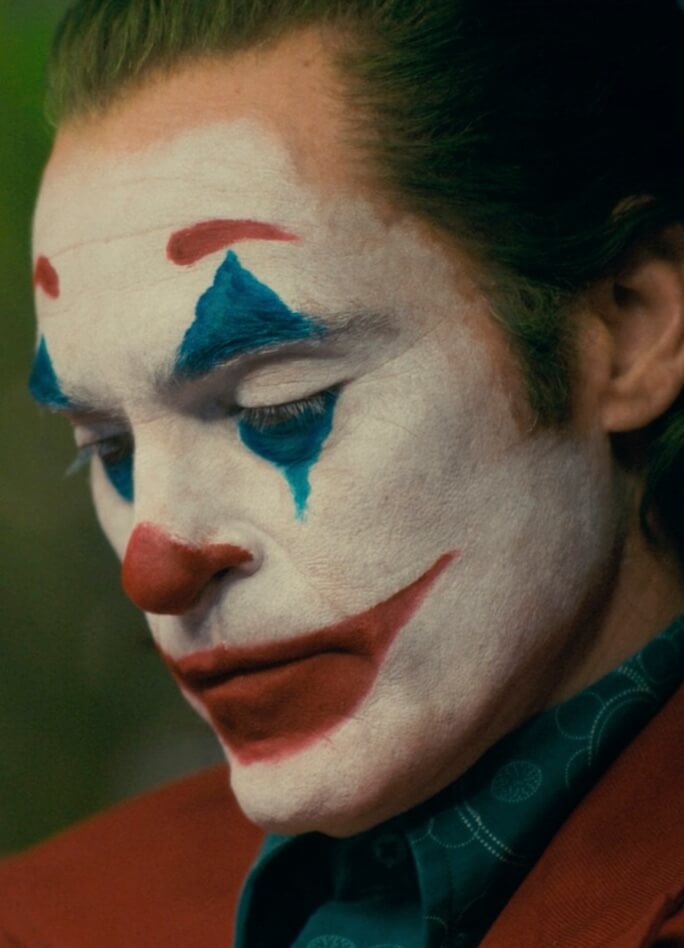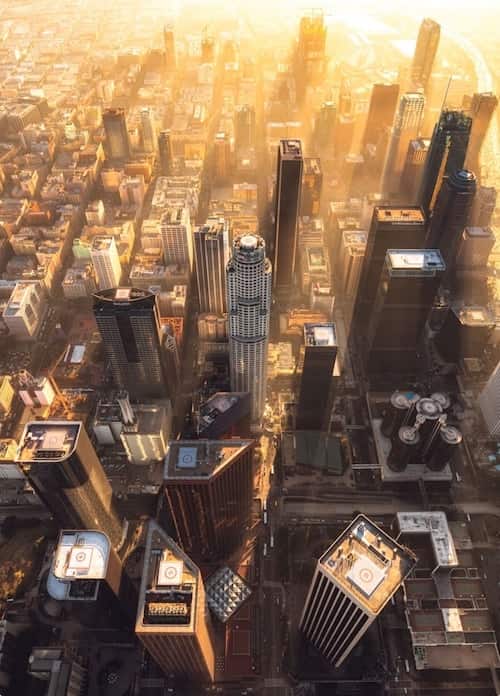It can be difficult to convey the importance of a landscape or emotion, especially when framing a subject at a distance with a wide shot.
Whether you’re making content for IMAX or an iPhone, scope matters. Today we’re going to go over the wide shot (aka “long shot”), and show you how it contributes to the scope of your story. We’ll cover the things you should consider before adding wide shots to your next shot list.
We’ll also cover establishing shots, extreme wide shots, and talk about how they can tastefully accentuate character and theme.
Let’s dive in!
Watch: The Ultimate Guide to Shot Sizes
Wide Shot intro
What does a wide shot do?
The wide shot is a director’s best friend. It’s an easy way to show where we are, and who’s with us, without having to move the camera too much.
WIDE SHOT DEFINITION
What is a wide shot (WS)?
A wide shot (WS), also referred to as a long shot, is a camera angle that shows the entire object or person and their relation to what surrounds them.
Wide shots in a nutshell
- They're commonly referred to as a "long shot"
- Shows the character or subject in relation to surroundings
- Can be captured by any type of camera or lens
- Often shot using wide angle lens
The wide shot lets the audience absorb all the information at once. That’s a lot of pressure! But let’s keep going with this dissection.
Since wide shots do such heavy lifting, we’ll pick apart this crucial shot with well-curated wide shot examples.
We’ll also break down how a wide shot fits into a scene or sequence, because no single shot truly stands alone. In this video, we break down all the standard shot sizes — how they work and what they're good for.
All camera angles and shot sizes explained • Subscribe on YouTube
Whether you’re creating a wide shot, aerial shot, close up shot, or another type of shot, it’s all about how your different shots fit together to build a scene.
How do all the shots engage the viewer? How does a director use a wide shot as one element to tell an effective story?
To find out, we’ll reverse-engineer key scenes that include wide shot examples.
We’ll illustrate what wide shots accomplish. You’ll see how master filmmakers plan wide shots and integrate them into their scenes, so that you come away prepared to elevate your own projects by using wide shots like a pro.
Camera Shots
Get Inspired. Explore More Shots.
Master every shot size, and learn how to combine them with angles and movements to take your filmmaking to the next level.
Close Up Shots
Medium Shots
Wide Shots
Wide shot examples
When to use a wide shot
The wide shot is crucial to every project. Let’s go over some common uses and break down why they are so important. Check out one of the best movies of 2011 - Terrence Malik’s Tree of Life.
Everyone wants to know what heaven looks like. You think you can do that without a wide shot? Absolutely not.



This is a sweeping wide shot. It’s used so we understand the breadth of Heaven. The woman at the center, the mother, is positioned to deflect the light. She’s looking away from us. As an audience, we want to follow her.
What about wide shots that convey the opposite effect?
Let’s take one of the best Quentin Tarantino’s films Django Unchained.
Here we have Jamie Foxx as Django, entering a plantation. If you squint you can see people watching Django in the background.
The framing makes Django stand out. He represents a bold statement about plantations.
Let’s look at how Quentin Tarantino planned it, shot by shot. In doing so we can see why this particular wide shot is so powerful in the context of the scene.
Even though a wide shot can look cool on its own, if it’s really going to stand out, it has to tell a story.
At the top of the scene, Betina points out the Brittle Brothers in the distance.
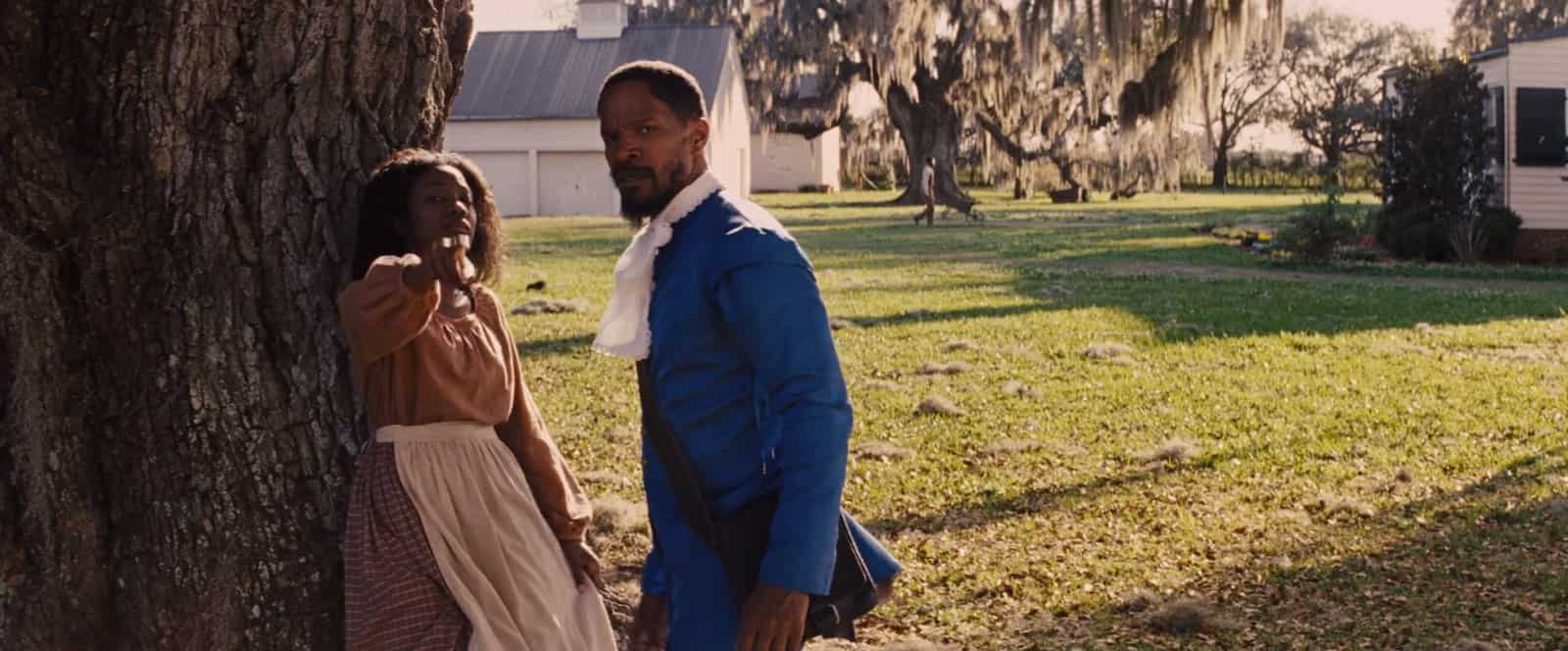


See Betina pointing them out?
Memories of their atrocities swirl in Django’s mind. We see flashbacks. He marches across the plantation for vengeance.
We follow Django to the end of a tracking shot, which ends in a dirty two shot over Django's shoulder. Tracking shots build anticipation, so Tarantino’s choice here effectively pulls in the viewer.



A dirty two shot connects Django and Brittle, and sets up the wide shot.
The effect emphasizes the physical distance between Brittle and Django, while also connecting the men. They’ve both arrived here, at this moment.
And how does Tarantino set this sequence in motion?
Pow: with a wide shot.
Full shot to the heart in Django Unchained
Here, the wide shot hits Brittle and the audience with Django’s might. His ridiculous outfit, previously mocked in the scene, now looks less like a joke and more like a superhero’s uniform.
It’s not only a wide shot. It’s also a low angle tracking shot, moving towards Django. This wide shot says: Django is different. He’s here to take action, right now.
Shot list like Tarantino. Check out the shot list and grab your discount code
Ideally, your shot list software will be visual. You’ll want to be able to upload images and try different views. This way, you can "see" your shots in advance.
Wide Shots Examples
Poetry of the wide shot
So, you have the perfect vista for your wide shot. What do you do now?
You need to put it in a shot list so your DP can anticipate and prep. Wide shots take lots of planning.
You’ll have to scout for where to set up the camera, and clear all the crew, so they’re not accidentally in the frame. Then wait for the light to be just right.
Specific camera movements matter too. Is your wide static? Are you tracking with someone on horseback, or in a helicopter?
What about on a crane or using a drone?
You want to capture all these crucial details in your shot list.
What can wide shots convey? How about isolation?



No one here but us spies in this long shot
We know Cary Grant’s character Mr. Thornhill is supposed to have a meeting with a man on a deserted road in North by Northwest. When he gets out into the middle of nowhere and confronts the only person there, he realizes it was all a setup.
Hitchcock uses this wide shot to show no one is around. It’s a sense of foreboding. Something terrible can happen to him out here, and there will be no one to hear him scream.
The big bulkiness of the wide shot belies texture, nuance, and grace. It’s all in how a filmmaker plans and executes it. With the right creative mind and creative tools, a full shot can contribute to a masterpiece.
Which seems like a good place to present to you Schindler’s List.
Related Posts
Wide shot example in film
Schindler's List shot
Schindler’s List is one of the most important films of the twentieth century. Spielberg, along with cinematographer Janusz Kamiński, uses wide shots scattered throughout the film to convey the horror and scope of the Holocaust.
It starts early, with the medical round up scene. Spielberg stays back so the audience understands how many people are being affected.
Eventually, Spielberg works into close up shots and medium shots as we get to know the people suffering.
But what about Schindler’s List’s most famous wide shot? It’s when Oskar Schindler sees the little girl in the red coat.
When you watch this scene, the wide shots are used to bring you into Schindler’s mind.
We’re constantly bouncing back and forth between a close up on his face and a wide shot where we follow the travesty and the little girl.
Here's the scene:
The long shot gives perspective in every way.
Spielberg aptly puts her in red to draw the audience’s eye as she moves. No matter how wide of a shot we get, we can follow her in the crowd.
So let's reverse-engineer the scene. We’ll find out how Spielberg uses his shot list to make it work. We broke down this scene into a shot list and specified the details of each shot.
Take a look below:
Schindler first watches the roundup unfold in a close up shot.
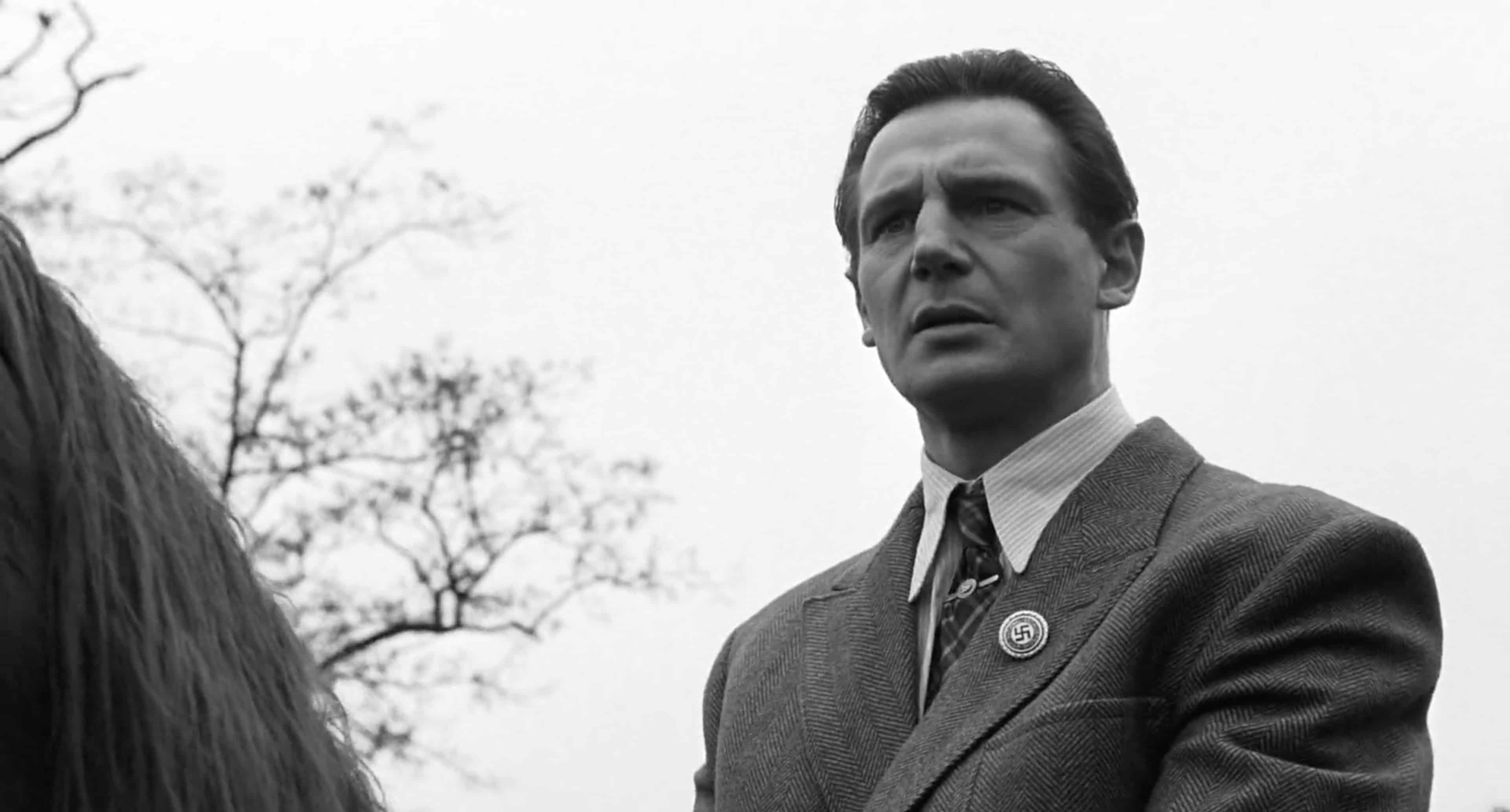


Schindler notices the missing girl
Why a closeup? So we can see his reaction, understand his shock, and feel his humanity. Then Spielberg gives us a wide shot of the little girl in red wandering into the street.



Notice how effective this wide shot is
The wide shot doubles as a POV shot for Schindler. The girl is the image of fragility and innocence, swept up in horror.
Spielberg bounces back to Schindler for another close up so we can connect to his reaction. But this time, we get even closer.



Closeup reaction shot from Schindler's List
Then, we return to the girl in wide.
The choice to show the girl in wide shots allows Spielberg to keep her at a distance — which created a visual motif. Wide shots, in this case, enhance her mystery, innocence, and vulnerability.
The girl captures our interest as she does Schindler’s. He follows her with his eyes. She walks down another street. As she does, Spielberg follows her with the most basic of all camera movements.
A pan.
We’re stuck in Oskar’s shoes. On solid ground, able to pivot and watch, but unable to move and help. No dolly shot, just a pivot.
These kinds of simple but meaningful choices might not be obvious at first thought. But if you’re using shot list software, all of the shot specs should be neatly organized into checkboxes for you, which makes it easier to question and experiment with the different effects of combining various shot specs.
Should this wide shot be combined with a pan? Or a tracking shot?
Combined with a low angle like in our Django Unchained example? Or a high angle? Or Oskar’s eye-line looking slightly downward? All of these combinations create a different effect.
Wide shots can carry deep messages. Especially if you set them up deliberately in a shot list to create depth and purpose.
As this shot list demonstrates, even Spielberg, one the most masterful of filmmakers, at the height of his acclaim, can communicate so much with a camera and tripod.
Filmmakers don’t always need cranes and explosions. Sometimes a pan, and the right wide shot, does it all.
Related Posts
Establishing
The establishing shot
We’ve touched on wide shots that inhabit deeper meanings.
But sometimes wide shots are only there to tell us where we are. Those kinds of wide shots are called establishing shots.
What is an establishing shot? They set up a scene, sequence, or even an entire film — that is, to visually establish the “where,” “when,” and specific feeling of the story’s surroundings — nothing compares to the establishing shot.
Establishing shot Definition (Es Definition)
What is an establishing shot (ES)?
An establishing shot (marked as ES on a shot list) is typically the first shot of a new scene. It can be accentuated with a wide shot, or an extreme wide shot. The establishing shot shows the audience where the action is taking place. They are frequently labeled with chyrons to indicate to the audience where we are in the universe.
In The Lord of The Rings, establishing shots set up the various kingdoms and cities the characters visit.



The establishing shot definition [Lord of the Rings: The Return of the King]
Establishing shots are such an integral part of cinematic storytelling, they’re ingrained in our understanding of story. This makes establishing shots very important. Here’s an establishing shot from Skyfall that shows a beautiful yet eery landscape where James Bone flees to as the story continues evolving.
We later find out this is actually part of James' mysterious past which is perfectly showcased in this wide shot.



Establishing shot from Skyfall
In Guardians of the Galaxy, we hit a different planet every ten minutes.
So to establish them, we go wide. It gives us the scope of outer space and also allows the VFX team to build unique worlds that look different.
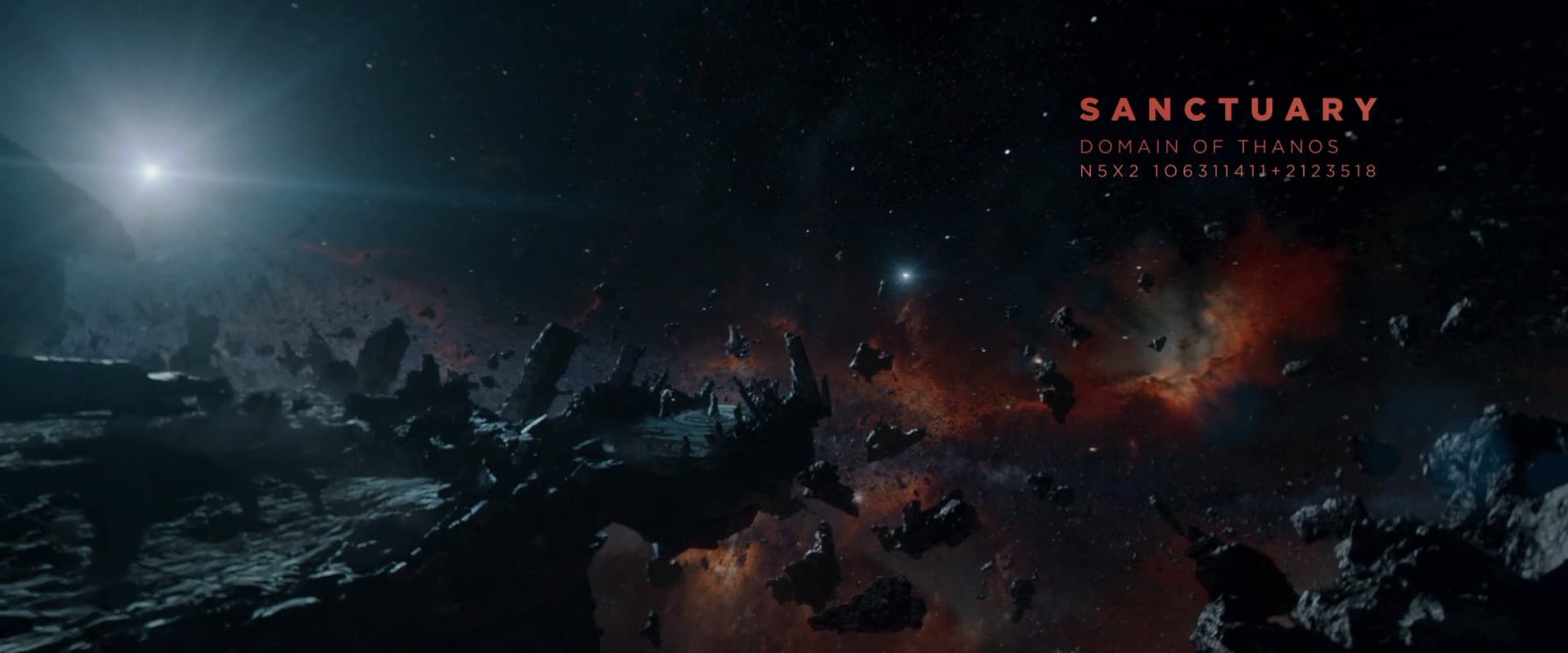


Seriously. We have memorized the establishing shot definition already.
But can you subvert the establishing shot?
David Fincher’s Fight Club ends the movie on an establishing shot of a new world. Tyler Durden’s plan works. All credit card debt has been erased.
The film fades out on an establishing shot of a new world juxtaposed against a couple holding hands. We’re establishing a new romance as well. Pun intended.



His name was Robert Paulson, am I right?
So what’s wider than a wide shot? Believe it or not, you can get wide. Like, really, really wide.
Extremely wide.
Related Posts
Extreme wide shot examples
When to use an extreme wide shot?
The extreme wide shot is utilized when you want a character to feel completely overmatched or unimportant in their world.
An extreme wide shot can also be used as an establishing shot. They’re wide — so, so wide — that a viewer can’t help but take in the full, wide scope of the setting being presented by the filmmakers.
EXTREME WIDE SHOT DEFINITION (EWS DEFINITION)
What is an extreme wide shot (EWS)?
An extreme wide shot (or EWS on a shot list) is a shot that is so wide, the subject is barely visible. The point of the extreme wide shot is to show what surrounds our subjects. The EWS can be used as an establishing shot.
What is an extreme wide shot?
- Example 1: A sweeping landscape, like in Gone With The Wind.
- Example 2: Outer space, like in Interstellar.
This is how we meet Rey in The Force Awakens. She’s a blip on a planet. A girl who was left behind. The movie then takes you on her journey. Her character arc is one that defines her importance.



Rey in an extreme wide shot example from The Force Awakens
Let’s try something a little closer than a galaxy far, far, away.
That is, in our own galaxy.
Think about Ridley Scott’s The Martian. That movie lives and dies on making Matt Damon’s character completely alone and insignificant on Mars.


The Martian lives on the wide shot
The most famous extreme wide shot comes from Lawrence of Arabia. It’s a film that is defined by its extreme wide shots of the desert. When you watch the scene play out you can see how breathtakingly amazing it is that David Lean took the time to show the scope of the desert in this way.
Extreme wide shot, extreme weather. Lawrence of Arabia - a wide shot film classic.
We experience the ride in real time. Lawrence is stuck in Arabia with no way out.
What else can an extreme wide shot do? What about using it to punctuate the emotional conclusion to a movie?
In The Good, The Bad, and The Ugly, we follow three men chasing buried treasure. Sergio Leone goes to the extreme wide shot at the end to show how far the men have come, and how far they still have to go.
There’s gold in them thar wide shots.
When you watch the entire scene you can see how Leone uses wide shots to prove a point. The distance between one another is a stand-in for the idea that they’re willing to kill and to die for the gold buried nearby. How do I know that? They’re surrounded by graves. Yeah, Leone is a master. This is a mic drop shot.
When you’re making your shot list, you’ll include wide shots, extreme wide shots, close ups, and any combination of other shots and elements. This is how to build scenes. This is how you plan your visual story.



Tarantino loves the extreme wide shot example [Inglourious Basterds]
Shot listing software and templates like StudioBinder make your filmmaking work easier. Plan your shots. Build your shot list. Tell the story you want to tell.
So get inspired. Get motivated. And start building your shots.
Camera Shots
Get Inspired. Explore More Shots.
Master every shot size, and learn how to combine them with angles and movements to take your filmmaking to the next level.
Close Up Shots
Medium Shots
Wide Shots
Up next
Creative ways to use medium shots
Now that you’ve got an excellent understanding of the wide shot, start thinking about how to employ it in your next production. For that, you’re going to need shot list software to make sure you consider the key shot requirements for your production.
Want to learn more about other angles? Perhaps get a little closer? Head to the blog where we will show you how to utilize medium shots to add nuance and meaning to your screenplay.
Up Next: The Ultimate Guide to Medium Shots →
Showcase your vision with elegant shot lists and storyboards.
Create robust and customizable shot lists. Upload images to make storyboards and slideshows.




